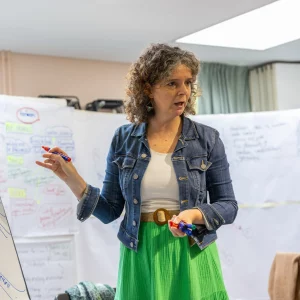A well-timed nod, or an ‘I see,’ shows you are engaged. These small cues encourage people to keep talking. They’re part of good listening, but they are not the whole story.
When someone else speaks, we’re often busy preparing our response, jumping to conclusions, or trying to solve their problem before they have even finished describing it. Our brain is wired to seek patterns, confirm our views, and protect our ego. Listening well requires us to slow that process down, to suspend judgment and be fully present. That takes attention, humility, and emotional energy.
So why bother?
Because deep listening is one of the most effective tools you have to build trust.
Whether you’re guiding agri-schools to connect with local businesses, coaching a cluster, or brokering trust between farmers and buyers — people want to feel seen and heard. When they do, they’re more open to sharing what really matters, not just what they think you want to hear. That’s when trust starts to grow!
Listening well also makes you smarter. You gain insight into what’s really going on, beneath the surface. You hear doubts, motivations, power dynamics. You catch the early signs of friction or opportunity. In short: you get access to information you’d never find in a survey or a spreadsheet.
And when people feel heard, they’re more likely to listen in return. That’s how partnerships start to feel like real partnerships, not just transactions.
What happens when you don’t listen?
When we don’t truly listen, we risk missing the core of what someone is trying to say — or worse, assuming we’ve understood when we haven’t. You may think you’re aligned, only to discover at a crucial moment that you never really were.
Agreements fall apart. Everyone goes their own way. Or nothing happens at all. In the kind of work we do – supporting change – that’s the last thing we want.
Poor listening also creates friction. People may feel ignored, misrepresented, or frustrated. Rebuilding trust takes much more time and energy than it would have taken to listen well in the first place. So don’t skip that step. It is not a luxury – it is a lever for change.
Four techniques to listen better
Listening is a muscle. You get better by using it deliberately. Here are four powerful techniques to train it:
1. Listen to understand, not to reply
It’s tempting to jump in with advice, opinions, or solutions. Resist that urge. Instead, try this mindset: “I’m not here to fix this, I’m here to understand it.” Ask yourself: What is this person really trying to say? What’s important to them? What might they not be saying directly? Let them finish. Then check your understanding by reflecting back what you heard. What was the message, and what seems important to the speaker? This helps build clarity and shows you’re really listening.
2. Create space for silence
Silence makes people uncomfortable which is exactly why it is useful. After someone finishes talking, wait a few seconds. Don’t fill the gap. Let the silence hang. Often, the most valuable things are said after the ‘official’ answer. This technique shows that you’re genuinely interested and willing to go deeper.
3. Notice what’s not said
Listening is not just about words. It is about tone, emotion, body language, and what may be left unsaid. A shift in tone, a hesitant pause, eyes lighting up are all part of the message. In cross-cultural or power-sensitive situations, people may not feel safe being direct. Sometimes they can’t. But that doesn’t mean they are not communicating. Learning to tune in to what is expressed through silences, gestures, or emotion – not just the verbal content – helps you grasp what is truly at stake. It takes patience and presence, but it can reveal needs, doubts, or desires that would otherwise stay hidden.
4. Dig deeper with curious questions
Active listening is more than hearing what is said. It’s about exploring it further. Once someone shares something meaningful, don’t rush to move on. Instead, ask open-ended questions that invite them to go deeper: How did that play out? What made that difficult? Can you give an example? These kinds of questions show genuine interest and help uncover context, motivation, and nuance. They move the conversation from surface-level to something richer, giving you a fuller, 360-degree understanding of the situation. We are not talking about an interrogation, but about staying curious and giving people the space to unfold their story in their own way.
Listening is a strategic skill
It builds trust, unlocks insight, and lays the foundation for real collaboration. So next time you catch yourself formulating a response before the other has even finished talking… pause. And listen – for real.


